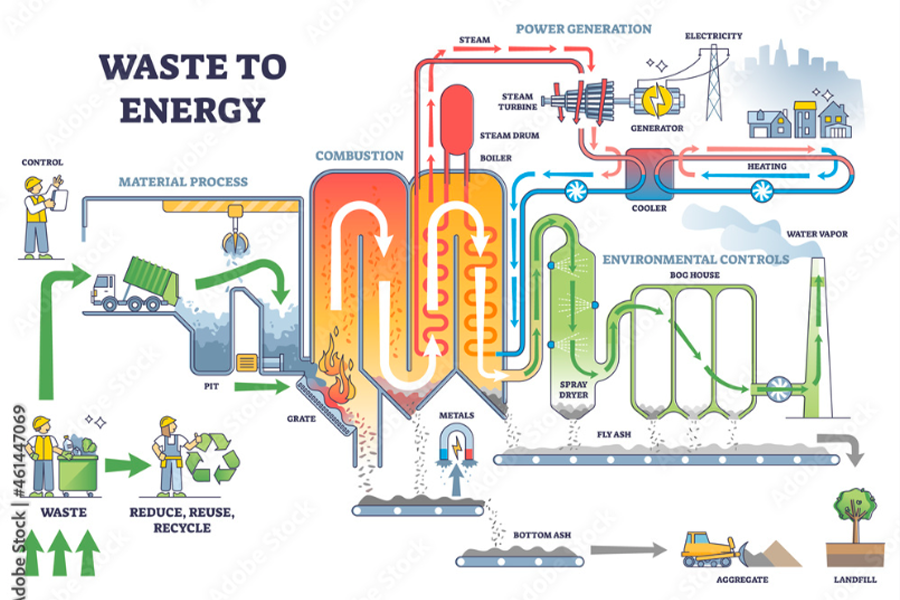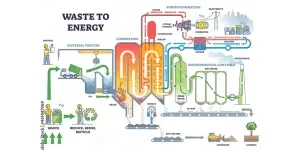The generation of power has historically been achieved via big power plants, such as nuclear power plants or coal-fired power stations. This has meant large amounts of waste in two ways: contaminating waste from power plants and “line loss,” or the loss of power during transit.
Today, moves toward renewable energy to supplement energy shortages and reduce waste are pushing the production and consumption of electricity in new ways. Proponents of distributed generation argue that this can be achieved by end users generating and storing energy in their homes and selling their excess back to the grid.
But what is distributed generation of electricity and how can it help the environment on a global scale? Read on.
Table of Contents
What is distributed generation of electricity?
What are the benefits of using distributed energy generation?
What are the disadvantages of using distributed energy generation?
What are the main technologies used in distributed generation of electricity?
Conclusion: What is distributed generation of electricity and what impact does it have on the environment
What is distributed generation of electricity?
The distributed generation of electricity refers to the production of energy on a local level by end users and the exchange of that electricity between the end user (the local energy producer) and the electricity grid in times of reduced energy production. This means that when an end user is generating more energy than they consume, they can sell it back to the grid. Likewise, when they are unable to generate enough energy, then they can buy what they are missing from the grid.
An example of energy distribution in this way would be when an end user’s renewable energy sources, such as solar panels, provide ample energy (in the summer months for example). At this point, the end user can keep the energy they need and sell the rest back to the electricity grid for distribution elsewhere – a very positive distribution effect. In the winter months, meanwhile, when the solar panels are no longer generating enough energy for that same end user, they can simply top up by buying some from the grid.
In addition to home energy production, a distributed energy generation system would increase the number of power plants, making more of them but on a smaller scale and closer to the end users. This serves to create a more local power grid that can easily interact with home energy production.
What are the benefits of using distributed energy generation?
There are many advantages to using a distributed generation of energy, including more customer independence, increased investment in renewable energy technologies, and less waste. Some of the key advantages are as follow:
Energy travels less distance
Electricity generation on a more localized level means that most (or all) of the required electricity will already be in the end user’s home. The main benefits of this include:
– Reduced line loss, as the power will not need to travel as far.
– Decreased demand on infrastructure, which in turn means less greenhouse gas emissions and power usage for the production of pylons and electricity cables, as well as less need for power plants.
– Less cost for customers as they will have their own energy resources.
Reduces the issue of delays and enormous power cuts
Currently, if the grid goes down, millions of individuals can be left without power, but with a distributed generation of electricity, power cuts would only affect a small area. In addition, if photovoltaic (PV solar power) generation is used, there is an increased possibility that power can be restored quickly. This type of national grid distribution generation of electricity is increasingly being looked into and researched.
Advances in renewable energy technologies
Having energy generation units at home means needing more innovation in clean energy technologies. This will mean increased funding in renewables such as solar, wind, natural gas from compost, and more. Additionally, the more electricity generated at home, the less reliance on central power generators, meaning power moguls will turn to investing in renewables to maintain profits.
Creates circular energy
Where some excess power may have been wasted with past models, distributed energy generation means users can buy and sell to the grid on a local level, meaning power is distributed around the community. Additionally, the use of combined systems, such as heat and power, mean that even very small amounts of power can be put to use by being combined to create a larger amount.
What are the disadvantages of using distributed energy generation?
Despite all its advantages, this type of electricity generation is in development and still has some issues to overcome:
Efficiency
Not every household has implemented its own energy generation unit, meaning that on a local level there may not be enough power to reduce reliance on the power grid at this point. In addition, renewable energy technologies have not yet reached their full capacity, making them less efficient than traditional methods. However, this is changing. In the US alone, solar panel installations increased by 43% since 2019, with more than 1 in 7 US homes predicted to have installed solar by 2030. This increase in investment and implementation will drive huge growth in the renewable energy sector.
Increased land area requirements
Although many distributed generation technologies will be constructed in homes, such as solar panels on roofs, small wind turbines in the garden, and natural-gas-fired fuel cells in barns and outhouses, there will still be a need for bigger power plants. In order to localize the power generated as much as possible, wind and solar farms, hydropower plants, municipal solid waste incineration plants, and more will all be constructed nearer to the communities that use them.
This will mean an increased demand for land area than in the past—meaning less land for reforesting, agriculture, and more. This could prove problematic in densely populated countries, such as the UK.
Air pollution
Those distributed generation technologies that use combustion will still pollute the air, and this system of distribution would mean that they are closer to populated areas. If systems are not implemented to reduce this risk, it could lead to health risks and contribute to global warming. Distributed energy solutions are constantly in motion though in order to lessen its environmental impact.
Water wastage
Some distributed generation technologies may require water for steam generation or cooling, as is the case with waste incineration, biomass combustion, and combined heat and power. This means that despite this distributed power system being a move toward sustainability and green energy, there will still be a need to use lots of water—our most precious resource.
What are the main technologies used in distributed generation of electricity?
The distributed generation of electricity is much broader than simply coal, nuclear, solar, gas, and wind. This type of energy generation system combines multiple types of power generators to cater to the demand and local geography and weather. Some of the most common are:
- Solar photovoltaic panels
- Small wind turbines
- Natural-gas-fired fuel cells
- Emergency backup generators
- Combined heat and power (CHP) systems
- Hydropower
- Biomass combustion/cofiring
- Municipal solid waste incineration

Conclusion: What is distributed generation of electricity and what impact does it have on the environment
Having answered the question of “what is distributed generation of electricity” as well as what type of environmental impact it has, both positive and negative – is it worth it?
Distributed electricity generation is a great way to reduce reliance on power supplies located far from the end user or customer. This means a reduction in line loss, transportation and infrastructure costs, and large-scale power outages.
In addition, this type of electricity generation funnels investment to renewable energy technologies and takes advantage of renewable energy sources. It also means that previously lost energy can be quickly recaptured and used.
However, distributed power generation does still have a footprint, including an increased need for land (to set up more localized power plants), potential water wastage when used for cooling, and an increase in air pollution located closer to urban areas. These issues are being addressed alongside the as-of-yet unfulfilled potential of renewables, such as solar.
With increased investment in the efficiency of renewables alongside a higher implementation of home power generators, such as wind, solar, and fuel cells, the carbon footprint of this localized energy model will be reduced.




